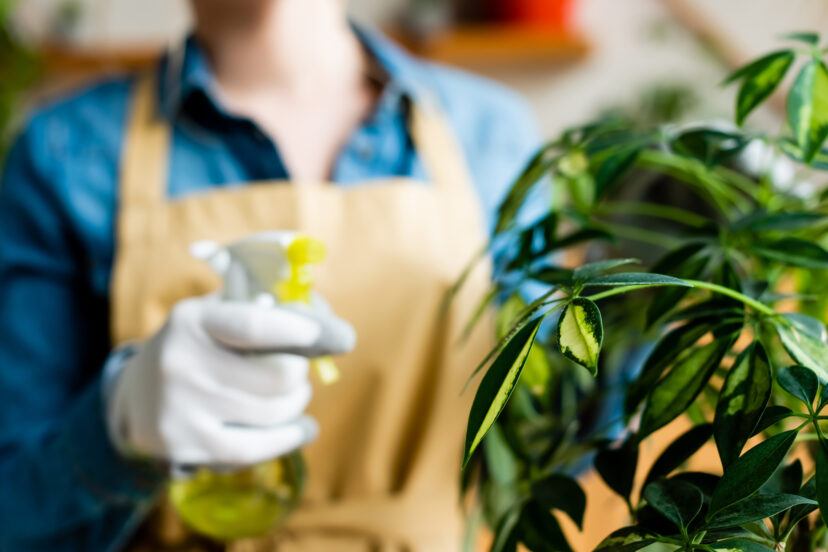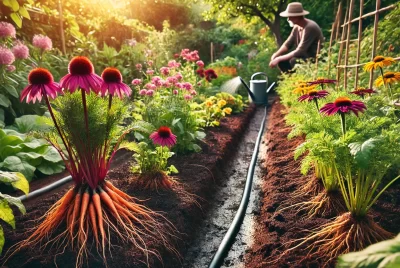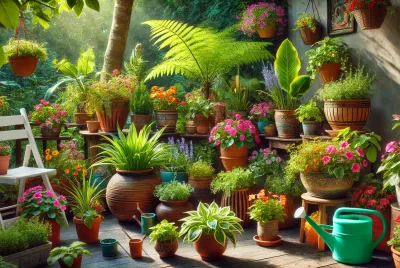Spray Bottle Gardening: A Water Efficient Gardening Approach
Spray bottle gardening is a fun and innovative way to grow plants, especially for those who might not have a lot of space or a traditional garden. Imagine being able to take care of tiny seeds and delicate plants with just a gentle mist from a spray bottle. This method isn’t just about saving space; it’s about creating a unique bond with your plants through daily care and attention.
Why Spray Bottle Gardening?
One of the biggest challenges in traditional gardening is managing water – too much or too little can harm your plants. Spray bottle gardening offers a solution to this by allowing for precise control over the amount of water your plants receive. This is particularly beneficial for seedlings and delicate plants that need gentle care.
But it’s not just about watering. Spray bottle gardening also makes it easier to provide your plants with nutrients through liquid fertilizers, and it’s a great way to keep the humidity levels just right for certain plants that thrive in a more tropical environment.
The Benefits of Spray Bottle Gardening
There are several benefits to this method. First, it’s incredibly water-efficient, making it an excellent choice for environmentally conscious gardeners. It also reduces the risk of diseases that can spread in overly wet conditions, such as fungal infections.
Another benefit is its accessibility. People of all ages and abilities can enjoy gardening with a spray bottle. It’s a simple, low-cost way to get started with gardening, and it can be done indoors or outdoors, in a backyard or on a windowsill.
Getting Started with Spray Bottle Gardening
To get started, you’ll need a few basic supplies:
A spray bottle:
Choose one that can mist finely to avoid overwhelming your plants.
Seeds or seedlings:
Start with plants that are known to respond well to this method.
Soil:
Use a light, well-draining soil mix suitable for your chosen plants.
Containers:
Any small containers or pots with drainage holes will work.
The key to successful spray bottle gardening is consistency and observation. You’ll need to pay close attention to your plants’ needs, adjusting the amount of water and nutrients as they grow. With a little patience and care, you’ll be rewarded with thriving plants that you’ve nurtured from the very beginning.
Choosing the Right Plants for Spray Bottle Gardening
Not all plants are suitable for spray bottle gardening. Seedlings, herbs, and certain houseplants that require a gentle touch when it comes to watering are ideal candidates. Examples include basil, cilantro, small succulents, and air plants. These plants benefit from the fine mist, which mimics their natural, humid environments.
Creating the Perfect Environment
Light:
Most plants thriving in spray bottle gardens need plenty of indirect sunlight. Place them near a window where they can bask in natural light without getting scorched by the direct sun.
Temperature:
Keep your spray bottle garden in an area with a consistent temperature, ideally between 65°F and 75°F, which suits a wide range of indoor plants.
Humidity:
Some plants might need a more humid environment. You can increase humidity by grouping plants together or placing a tray of water near your garden.
Watering Techniques
Watering with a spray bottle is not just about spraying; it’s about understanding the needs of your plants. Here’s how to do it right:
Mist Seedlings:
Young plants and seedlings should be misted lightly to keep the soil moist without waterlogging.
Foliage Feeding:
Some plants benefit from having their leaves misted, which can help clean the leaves and provide them with direct hydration.
Root Watering:
For larger plants, use the spray bottle to gently water the soil at the base of the plant, ensuring the roots get enough moisture.
Fertilizing and Plant Care
While water is crucial, plants also need nutrients to thrive. You can use a diluted liquid fertilizer in your spray bottle to feed your plants. Do this sparingly, as over-fertilizing can harm your plants. A good rule of thumb is to fertilize once a month during the growing season.
Pest Management
Spray bottle gardening also offers a natural way to deal with pests. A mixture of water and mild soap can deter pests like aphids and spider mites without harming your plants. Be sure to rinse the leaves with plain water afterward to remove any soap residue.
Common Challenges and Solutions
Overwatering:
This is a common issue in spray bottle gardening. If you notice yellowing leaves, reduce your watering frequency.
Underwatering:
If leaves look wilted or dry, increase your watering. Remember, the goal is to keep the soil moist, not soggy or dry.
Mold Growth:
If you see mold on the soil, it’s a sign of too much moisture. Reduce watering and increase air circulation around your plants.
Experimenting with Spray Bottle Gardening
Don’t be afraid to experiment with different plants and setups. Try creating a mini greenhouse by covering your plant with a clear plastic bag to retain humidity. Adjust your care routine based on the season and the specific needs of your plants. Observation is key; the more you learn about your plants’ preferences, the more successful your garden will be.
Spray bottle gardening is a wonderful way to connect with nature, whether you’re a seasoned gardener or just starting. By paying attention to the needs of your plants and providing them with the right care, you’ll create a thriving garden that’s both beautiful and rewarding.
As we wrap up our journey into the world of spray bottle gardening, let’s revisit the key points that make this gardening method both effective and enjoyable. From the initial setup and choosing the right plants to mastering watering techniques and overcoming common challenges, spray bottle gardening opens up a world of possibilities for gardeners of all levels.
Recap of Key Points
Choosing the Right Plants:
Opt for seedlings, herbs, succulents, and air plants that thrive under a fine mist.
Creating the Perfect Environment:
Ensure your plants receive plenty of indirect sunlight, maintain a consistent temperature, and adjust humidity levels as needed.
Watering Techniques:
Use a gentle mist for young plants and adjust your approach for foliage feeding and root watering to meet the needs of larger plants.
Fertilizing and Plant Care:
Provide your plants with the nutrients they need through diluted liquid fertilizer, but be careful not to overdo it.
Pest Management:
Combat pests naturally with a mix of water and mild soap, ensuring to rinse your plants afterward.
Common Challenges:
Learn to recognize signs of overwatering, underwatering, and mold growth, and adjust your care routine accordingly.
The Joy of Spray Bottle Gardening
Spray bottle gardening isn’t just about growing plants; it’s about cultivating a deeper understanding and appreciation for the living world around us. It encourages us to observe, experiment, and learn from the plants we care for. This method of gardening is accessible, eco-friendly, and immensely satisfying, making it an excellent hobby for those looking to start their gardening journey or seasoned gardeners exploring new techniques.
Conclusion
In the end, spray bottle gardening exemplifies how small actions can lead to flourishing growth. Whether you’re tending to a windowsill of herbs or nurturing a collection of exotic air plants, the principles of care, observation, and adaptation apply. This method teaches us the importance of paying attention to the little details, the very essence of what makes gardening so rewarding.
So, grab a spray bottle, select your seeds or seedlings, and embark on a gardening adventure that’s not only manageable but deeply gratifying. As you mist your plants, remember that each spray is a step towards a greener, more vibrant world. Happy gardening!
FAQ: Spray Bottle Gardening
1. What types of plants are best suited for spray bottle gardening?
Answer: Ideal candidates for spray bottle gardening include seedlings, herbs (like basil and cilantro), small succulents, and air plants. These plants benefit from the gentle, humid conditions that a fine mist provides, mimicking their natural environments.
2. How often should I water my plants with a spray bottle?
Answer: The frequency of watering depends on the specific needs of your plants, the humidity level of your environment, and the season. Generally, seedlings and young plants should be misted daily to keep the soil moist but not waterlogged. Observe your plants and adjust as needed, ensuring the soil is never completely dry nor overly saturated.
3. Can I use tap water in my spray bottle for gardening?
Answer: Yes, tap water is generally fine for most plants. However, if you know your tap water is hard or contains high levels of chlorine or fluoride, consider using filtered or distilled water to avoid potential harm to sensitive plants.
4. How do I prevent mold growth in my spray bottle garden?
Answer: To prevent mold, avoid overwatering your plants and ensure there’s good air circulation around them. If mold appears, reduce the frequency of watering and consider moving your plants to a brighter or more ventilated area. Removing any visibly moldy soil and replacing it with fresh, sterile potting mix can also help.
5. Can spray bottle gardening be done outdoors?
Answer: Absolutely! While spray bottle gardening is often associated with indoor gardening due to its precise control over watering, it can also be adapted for outdoor use, especially for tender plants or seedlings that require a gentle touch. Just be mindful of outdoor conditions, such as wind and sun exposure, which might necessitate more frequent misting to maintain moisture levels.




